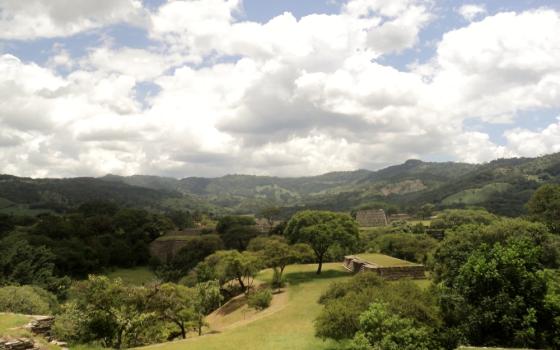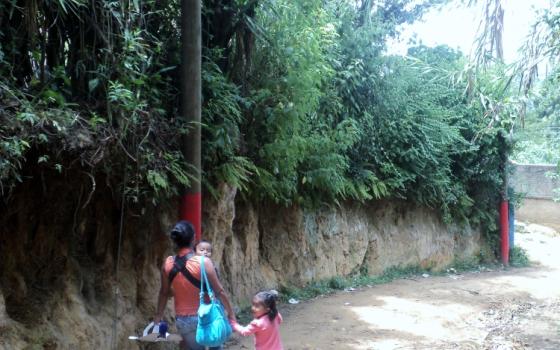It was one of those conversations that happens when you ask the right question without intending to ask the right question, and then someone is willing to show you a piece of their soul.
I was strolling along with Ana (name changed), a Guatemalan woman in her early 40s, as the golden afternoon sunshine bathed the hills surrounding Guatemala City. I had arrived to this country a few weeks before for a month-long ministry experience as part of my Apostolic Novitiate. Here, small cement houses dotted the landscape, and chickens were clucking amid the rows of cornstalks. We walked slowly down the steep stone- and grass-covered path toward a cement school building. We hoped to visit an adult education class where people who didn’t get to study as children can, little by little, finish grade school. Having arrived a bit early, in a culture where punctuality is not standard, we enjoyed the chance to walk and talk.
“How many siblings do you have?” I asked Ana.
“Eight. Well . . . we were eight. Now we’re seven. They killed my oldest brother,” she replied.
“They killed him? In the war?”
“Sí,” she said, her eyes conveying a hint of sadness but also normalcy, that it was nothing out of the ordinary in this country.
As Ana proceeded to tell me the story of her family, the scenery around us seemed to fade away. She grew up in a tiny village where her father farmed corn and beans. Her eyes danced when she spoke of childhood days helping her family in the field. It was a simple life, she said, but happy.
One night, when Ana was about 12, her oldest brother did not return home from pasturing the cows. Fear seized the family, as throughout the country people were being kidnapped and killed in what would become known as Guatemala’s horrific 36-year civil war. The next morning, her brother’s corpse was discovered tossed along the side of a road. They never found out if it was the Ejercito (army) or the Guerrillas (leftist opposition groups) who killed him. However, they knew their family could be in danger. They gathered what belongings they could carry and fled to a nearby village. Here, a couple gave them shelter in what had been a barn for animal feed.
The very next day, word came that the Ejercito had arrived to Ana’s village and massacred almost everyone who lived there. Men, women and children – it didn’t matter. It was disgusting, senseless killing with guns, clubs and machetes. A few nights later, the Guerrillas slipped into the village where Ana and her family were seeking safety. Through the night, they heard gunshots and screams. At one point, they were paralyzed with fear as the voices of angry men drew close to the shed where they hid. She remembers staying very still until thankfully the killers passed by, thinking it was indeed just an animal feed barn.
In the morning, Ana said, those who had survived emerged to find the aftermath. The couple who has given them shelter was among the dead. The Ejercito swooped in to look like the “good guys,” even though the U.N. found state forces to be responsible for 93 percet of assassinations during the war. They helped families put their dead in wooden coffins; there were 40 to 50 in all. A few days later, Ana’s family and many others processed with the coffins and Ejercito escorts to the nearby larger town of Chinique.
I almost couldn’t breathe as I watched the story flow from Ana’s lips. She is an intelligent, energetic, and joyful woman who is working toward an administration degree. I would never have guessed the traumatic past that she had lived. But then, it is the story of so many in this country. Around 200,000 people were killed or disappeared in the war years. Thousands of them have never been found or identified. A current billboard here advertises an organization that supports those still searching for relatives lost in the war. “Do you need help finding your disappeared loved ones?” it reads. “Call us.” Violence has been woven into the fabric of Guatemalan life. Many, like Ana, press on with resilience in order to survive.
Latin America is so often a juxtaposition of pain and beauty. Pain, certainly. Almost all Central and South American countries have pasts filled with violence and oppression. It wasn’t until I traveled to Chile as a college sophomore that I began to learn of the horrific human rights violations in that country and others, and especially, the United States’ role in promulgating them. Guatemala is no exception to this deep pain. It is even home to oft-overlooked martyrs like Fr. Stan Rother, Bishop Juan Gerardi and Sr. Barbara Ford.
On top of the unspeakable genocide that overshadows their recent history, the Guatemalan people suffer pervasive daily struggles of hunger, unemployment and underemployment, domestic violence, alcoholism and drug addiction, and lack of adequate health care and education, to name a few. Guatemala is 133 out of 187 countries in the U.N.’s 2013 Index for Human Development. According to the same study, eight out of ten people live under the poverty line. This year is proving to be especially dire. The Prensa Libre reports that due to extreme drought during what should be the rainy season, over 8,000 poor corn-farming families have lost their corn crop. Other families struggle as food prices rise.
Mixed with all of this darkness is bursting color. Guatemala itself is a breathtaking country: fabulous shades of green on patched hillsides, bright flowers and the most brilliant hued fabrics of the indigenous cultures. It is a place of warmth, hospitality and devoted faith. Christ’s resurrection sparkles in sincere smiles and kind eyes. Hope echoes in food, dance, song and celebration. Many people are working to help heal the brokenness and develop a brighter future.
I got to witness one of those bright spots up close during my month in Guatemala. While discerning a place for a ministry experience, I felt a pull to this country, where Sr. Sarah Mulligan has directed the Clínica Comunitaria Daniel Comboni for the last 20 years. Sr. Sarah is a nurse by training and many, many other things by experience. The Clínica is located in Mixco, an area outside the capital that has developed over the last two decades but remains home to great poverty. Here, Sarah has heard thousands of stories like Ana’s. She has fallen in love with this people and worked side by side with them to create a holistic health center that is truly of the community. In addition to affordable medical and dental services, there is a library, a diabetes support group, a women’s empowerment program, early childhood stimulation classes, and a children’s nutrition program. It is a place that brings to life the saving and healing mission of Jesus Christ.
Guatemalan life seems to be drenched with the Paschal Mystery. It is a place that undoubtedly knows both death and life and how they so often flow out of each other. I am grateful for the opportunity I’ve had to touch into this Mystery. For me, the month was a return to the type of culture that initially set my heart on fire and impelled me to explore religious life. Both the light and the darkness show me that I cannot follow Christ and sit still. Christ is joy and resurrection that bid us to celebrate, and Christ is the suffering of our sisters and brothers that beckons us to action. Especially as thousands of migrants flee from Guatemala and surrounding nations, I pray to be part of the resurrection.
[S. Tracy Kemme is a novice with the Sisters of Charity of Cincinnati. Author of the blog, Diary of a Sister-in-Training, Tracy is excited about the future of religious life! She has a background in Hispanic ministry, having served both in Ecuador and at the U.S.-Mexico border prior to novitiate.]
Editor's note: Read more about Tracy’s experience of the current situation in Guatemala in Part II.









